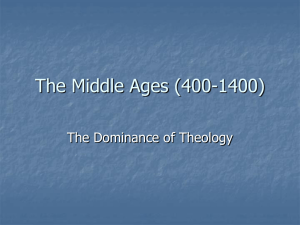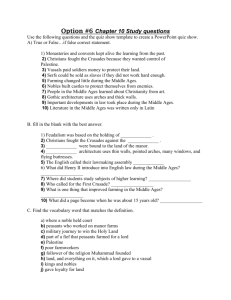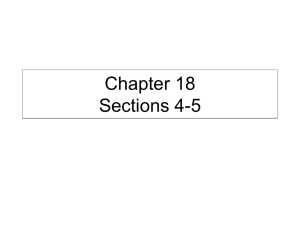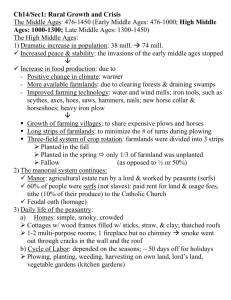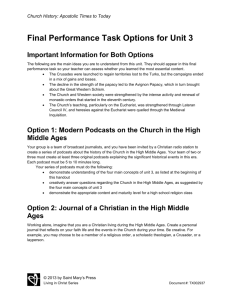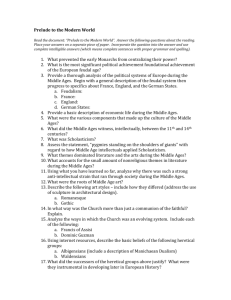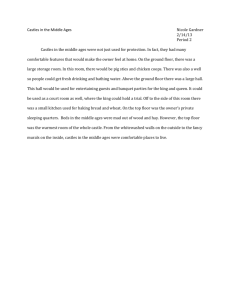Worksheet
advertisement
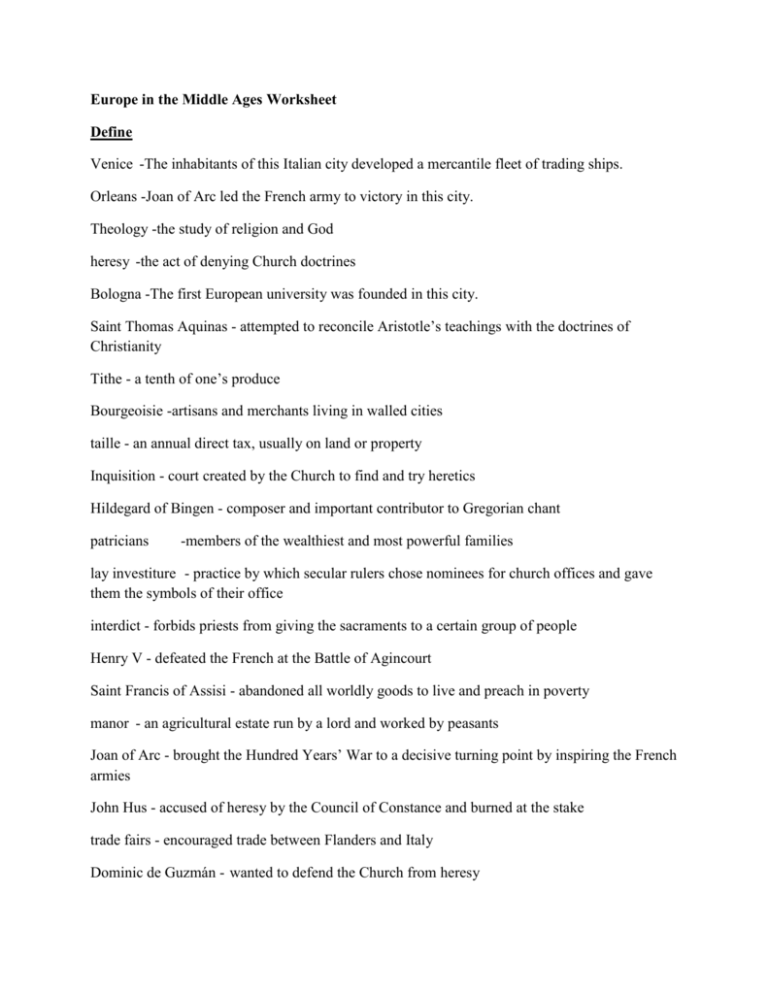
Europe in the Middle Ages Worksheet Define Venice -The inhabitants of this Italian city developed a mercantile fleet of trading ships. Orleans -Joan of Arc led the French army to victory in this city. Theology -the study of religion and God heresy -the act of denying Church doctrines Bologna -The first European university was founded in this city. Saint Thomas Aquinas - attempted to reconcile Aristotle’s teachings with the doctrines of Christianity Tithe - a tenth of one’s produce Bourgeoisie -artisans and merchants living in walled cities taille - an annual direct tax, usually on land or property Inquisition - court created by the Church to find and try heretics Hildegard of Bingen - composer and important contributor to Gregorian chant patricians -members of the wealthiest and most powerful families lay investiture - practice by which secular rulers chose nominees for church offices and gave them the symbols of their office interdict - forbids priests from giving the sacraments to a certain group of people Henry V - defeated the French at the Battle of Agincourt Saint Francis of Assisi - abandoned all worldly goods to live and preach in poverty manor - an agricultural estate run by a lord and worked by peasants Joan of Arc - brought the Hundred Years’ War to a decisive turning point by inspiring the French armies John Hus - accused of heresy by the Council of Constance and burned at the stake trade fairs - encouraged trade between Flanders and Italy Dominic de Guzmán - wanted to defend the Church from heresy Investiture Controversy - the struggle between Henry IV and Gregory VII scholasticism - chief task was to harmonize Christian teachings with the works of Greek philosophers vernacular - the language of everyday speech in a particular region Answer What was the gild system and how did it work? What did the counts of Champagne do in order to encourage trade between Flanders and Italy? - initiated a series of trade fairs in the chief towns of the territory. How were Serfs different from peasants? - were legally bound to the land upon which they worked and lived. Explain the struggle between Henry IV and Gregory VII. How did Joan of Arc bring the Hundred Years’ War to a decisive turning point? - inspiring the French with her faith. Spain’s two strongest kingdoms—Castile and Aragon—were united when what event took place? - Isabella married Ferdinand. Elections for city council in medieval cities were often…. - carefully rigged to make sure that only patricians were elected. To achieve his political ends, what did Pope Innocent III do? - often used an interdict, which prohibited priests from giving the sacraments of the Church to a particular group of people. After the Hundred Years’ War, what event took place causing England to faced more turmoil?from - the War of the Roses. During the High Middle Ages, people counted on the church for sacraments, such as baptism, ____________________, and the Eucharist in order to receive salvation. (marriage) What invention as a weapon helped the outnumbered English foot soldiers to defeat the impressive French army? - longbow Essays Describe the three factors that led to the decline of the papacy during the Late Middle Ages. As kings became more powerful in Europe during the Late Middle Ages, they began struggling with popes for control. This struggle seriously weakened the papacy. The Great Schism, a fight between French and Italian churchmen, also weakened the Church by splitting it into two factions. The people did not lie to see Church leaders fighting for political power and wealth. Finally, they began to demand reform. Describe the factors leading up to the Inquisition and how the thirteenth-century Church dealt with heretics. A breakaway group of Franciscans challenged the leadership of their order. The Beguines, a group of enthusiastic Catholic women outside the Church’s control supported them. The Church feared these challenges to its authority, calling those disobedient to the Church heretics, and used the Inquisition to find and punish people who had committed heresy. If people confessed, they were sentenced to an act of penance, often a pilgrimage. However, if the people did not confess to heresy, they were found guilty and often executed by burning at the stake. Give an example of a saint recognized by Christians in the High Middle Ages and explain the role that saints played in religion. Examples include the Virgin Mary, Saint Nicholas, Saint Francis and apostles of Jesus. People believed that saints were men and women who were exceptionally holy, and had achieved a special place in Heaven. Saints could request special favors from God for people who prayed to them. Many Christians went on pilgrimages to the shrines of various saints. Compare the two-field and three-field systems of farming. In the early Middle Ages, peasants divided their land into two fields of equal size. One field was planted, while the other was allowed to lie fallow to regain its fertility. Later, however, lands were divided into three parts. One field was planted in the fall with grains that were harvested in the summer. The second field was planted in the spring with grains and vegetables that were harvested in the fall. The third field was allowed to lie fallow. The three-field system meant that only one-third, rather than one-half, of the land lay fallow at any given time. The rotation of crops also kept the soil fertile and allowed more crops to be grown. Identify the economic consequences of the Black Death. The Black Death epidemic and the death of so many people had severe economic consequences for the people of Europe in the Middle Ages. Trade declined, and a shortage of workers caused a dramatic rise in the price of labor. At the same time, the decline in the number of people lowered the demand for food, resulting in falling prices. Landlords were now paying more for labor, while their incomes from rents were declining. Some peasants who survived the Black Death bargained with their lords to pay rent instead of owing services. In essence, this change freed them from serfdom, an institution that had been declining throughout the High Middle Ages. Explain how the slow shift from bartering to a money economy began to emerge in the Middle Ages. The shift from bartering to a money economy emerged in the Middle Ages when the demand for gold and silver coins arose at fairs and trading markets of all kinds. Trading fairs had been initially established by the counts of the Champagne region of France in order to encourage trade between Italy and Flanders. Slowly, a money economy began to emerge. New trading companies and banking firms were set up to manage the exchange and sale of goods. All of these new practices were part of the rise of commercial capitalism, an economic system in which people invested in trade and goods in order to make profits. Explain why the Hundred Years’ War was a turning point in the style of warfare. The Hundred Years’ War proved to be a turning point in the ways of warfare in several ways. First, it proved the value of peasant foot soldiers over heavily armored and mounted knights. The French knights looked down on foot soldiers as inferior. At the battle of Crécy, the English armies proved that foot soldiers could defeat knights in battle, especially through the use of the longbow, which was another new aspect to warfare. Finally, toward the end of the war, the use of the cannon changed the face of warfare forever and helped the French defeat the English armies.

